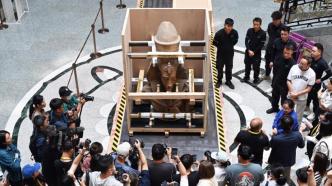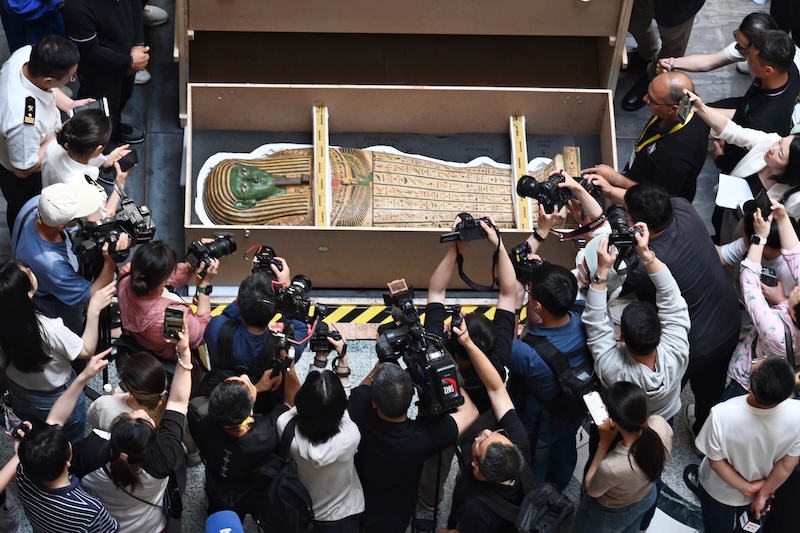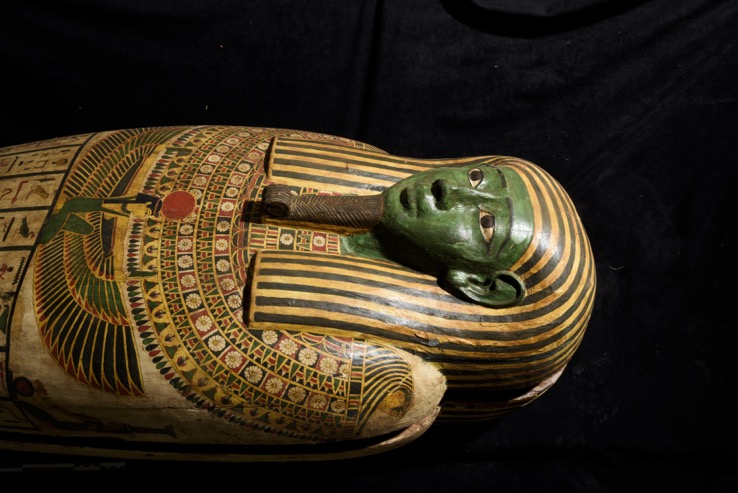

"Top of the Pyramids: Ancient Egyptian Civilization Exhibition" will be held at the People's Square of the Shanghai Museum on July 19. A chartered cargo plane loaded with ancient Egyptian artifacts took off from Cairo and arrived in Shanghai in the early morning of June 16. On the evening of June 16, nine buses carrying the special exhibition artifacts arrived at the People's Square of the Shanghai Museum.
On the afternoon of June 17, two ancient Egyptian artifacts, the colossus of Akhenaten and the painted human-shaped coffin, were unpacked in the lobby of the People's Square of the Shanghai Museum, unveiling their mysterious veil. Akhenaten was the pharaoh of the 18th Dynasty of ancient Egypt and the father of Tutankhamun, the most well-known pharaoh of ancient Egypt; the painted human-shaped coffin was unearthed in the ruins of the Cat Temple in Saqqara, Egypt in recent years. The wooden coffin is particularly recognizable because of the green painting on the face.

The Colossus of Akhenaten unboxing scene (Photo by Zhu Weihui of The Paper)
"Top of the Pyramids: Ancient Egyptian Civilization Exhibition" is the world's largest and Asia's highest-level exhibition of ancient Egyptian cultural relics abroad. It will include 787 cultural relics from different periods of ancient Egyptian civilization selected from many Egyptian museums and will be on display for more than a year. The exhibition aims to reveal the appearance of ancient Egyptian civilization to the audience and announce the latest archaeological discoveries and research results of ancient Egypt.

The Colossus of Akhenaten unboxing scene (Photo by Zhu Weihui of The Paper)
At 1:30 pm on June 17, The Paper reporter saw two huge crates containing ancient Egyptian artifacts quietly placed in the lobby of the Shanghai Museum (People's Square). The first artifact to be unpacked was the "Colossus of Akhenaten". The crate containing the artifact was more than 2 meters high. After removing the seal and unpacking the crate, the long-faced, thick-lipped "Colossus of Akhenaten" that had been repeatedly exposed in video materials suddenly appeared before our eyes.
Akhenaten was a pharaoh of the 18th Dynasty of Ancient Egypt and the father of Tutankhamun, the most well-known pharaoh of Ancient Egypt. This sculpture shows a bust of Akhenaten, but it is 2.1 meters high and looks majestic. This artifact is now in the collection of the Egyptian National Museum.
According to reports, this colossus is one of a group of similar statues, originally about 4 meters high, arranged on the south wall and the south end of the west wall of the open-air courtyard of the Temple of Aten in Karnak. The statue is completely different from the traditional heroic and muscular shape of the pharaoh, and all the lines are elongated.
King Akhenaten (Amenhotep IV) moved the capital to Amarna in the fifth year of his reign, promoted religious reforms, abandoned all gods, and worshipped Aten alone. Aten's image was a sun wheel. Akhenaten advocated worshipping only Aten and abolished the cumbersome temple rituals. He communicated directly with the god Aten in a simple way in the open courtyard. He called himself the only son of Aten and the only intermediary between gods and humans. Only the royal family could participate in the rituals and interact with Aten.
After Akhenaten's death, his monuments were removed or hidden until the early 1820s, when the hieroglyphics were deciphered and Akhenaten's name became known again.

The unpacking scene of the "Painted Humanoid Coffin" (Photo by Zhu Weihui of The Paper)
Another cultural relic, the "Painted Humanoid Coffin", was unearthed in recent years from the Cat Temple site in Saqqara, Egypt. Compared with other humanoid coffins unearthed from the Saqqara site, this painted wooden coffin is particularly unique because of the green paint on the face, and is highly recognizable, so it is called the "Green Face Coffin". According to Chu Xiaobo, director of the Shanghai Museum, this is also the first time that this "Green Face Coffin" has been exhibited abroad outside of Egypt.
Due to the special material of the "Green-faced Coffin", and for the sake of cultural relic protection, the unpacking scene was done with greater caution, with only a brief "reveal" of the coffin. The museum also repeatedly reminded visitors not to turn on the flash or turn off the lights when taking photos.
It is reported that the human-shaped coffin is the most common type of coffin since the late Middle Kingdom. In recent years, archaeological excavations in the Saqqara area have unearthed nearly a thousand human-shaped coffins in the Saqqara catacombs, providing a large amount of new material for the study of coffins, filling the gap in northern samples, and may very well break the original classification system.

Painted human-shaped coffin
The green color of the face of this painted wooden coffin symbolizes the legendary resurrection of Osiris from the dead, and also represents the flooding Nile River.
In addition to the exposed green skin and the false beard commonly seen on mummies, the deceased Nehshutbiti also wore a Nemes turban, which indicated his ascension to the gods, and a wide collar, which also symbolized the deceased. Unlike ordinary chest ornaments, the wide collar on this coffin is finely painted and complexly decorated. It is divided into twelve layers, and there is a circle of pendants on the outermost layer. Below the wide collar, the goddess Nut is kneeling with her wings spread out, her upper body naked, and a sun disk with a golden outline painted on her head.
This "green-faced coffin" is a typical human-shaped coffin with a base. The inscription on the outside of the coffin extends from the middle to the base, and there is also a line of inscriptions on the base. There are also inscriptions on the back of the coffin.

Saqqara Archaeological Site
This cultural relic will be presented in the second section of "Top of the Pyramids", "Secrets of Saqqara". This section mainly focuses on the major discoveries made by the Egyptian archaeological team in the Saqqara area in recent years. Chu Xiaobo said that many of the cultural relics displayed in the "Secrets of Saqqara" section are announced to the public for the first time, and may not be seen even in Egypt, because most of the cultural relics are still stored in local warehouses. This time, the Shanghai Museum working group went to Egypt to check and hand over cultural relics, and some of the cultural relics were directly handed over and shipped to Shanghai from the archaeological warehouse near the Saqqara archaeological site.


